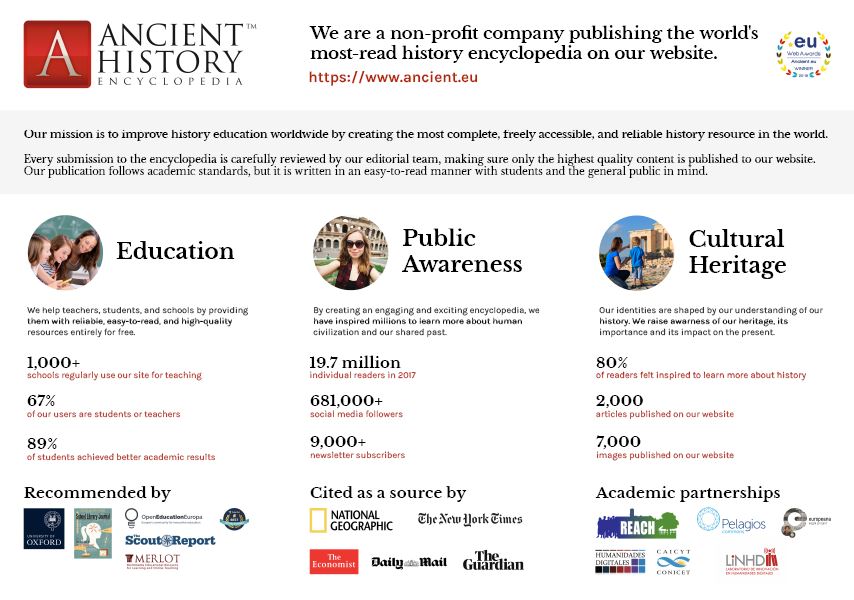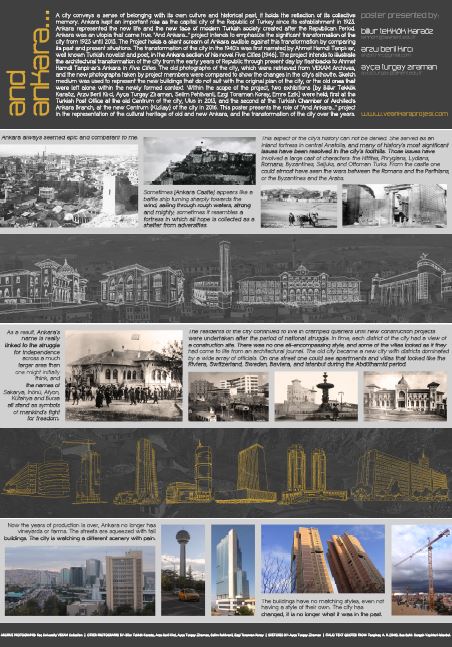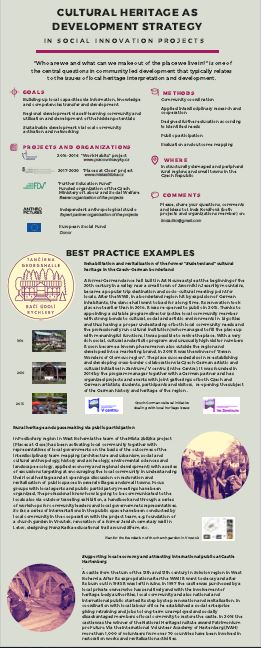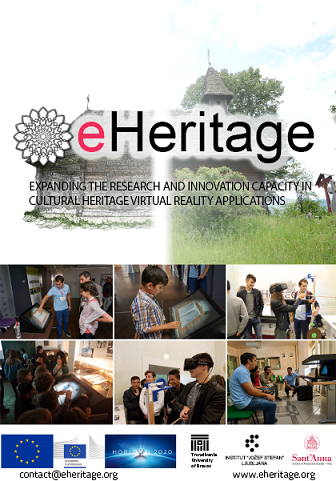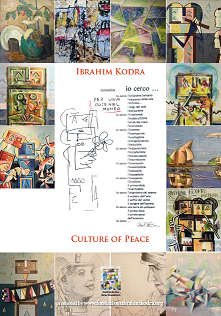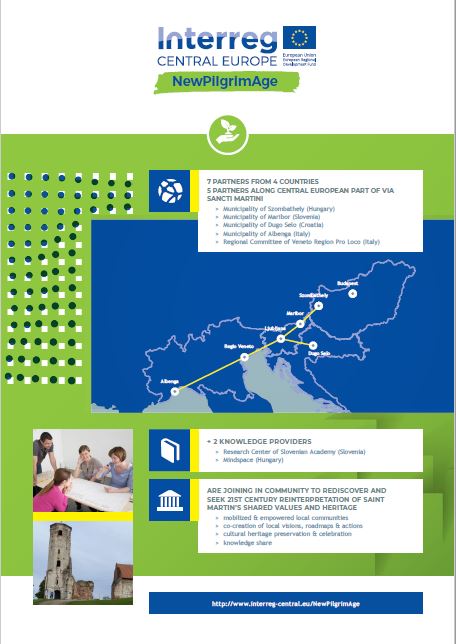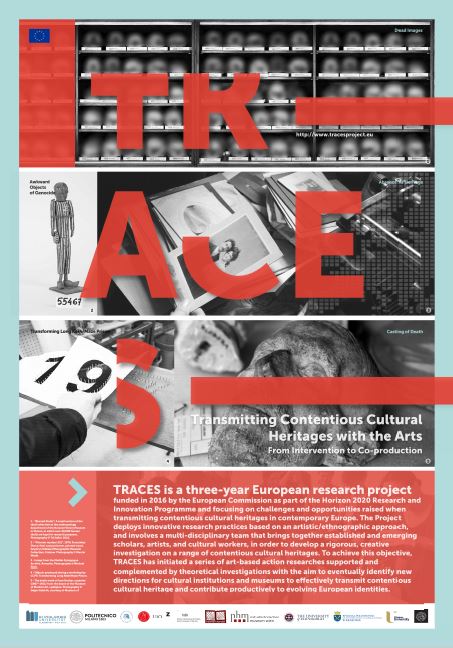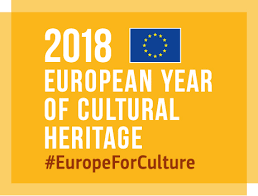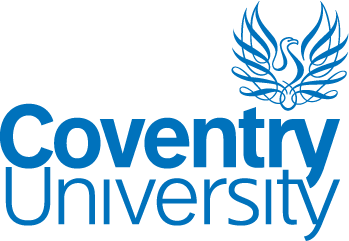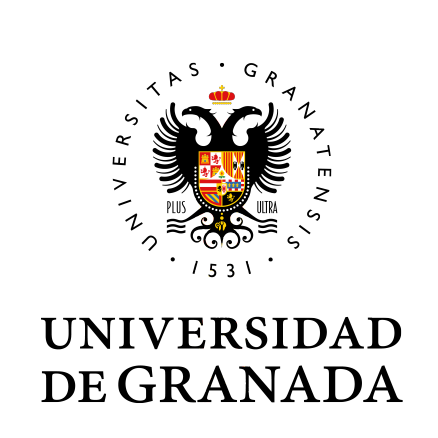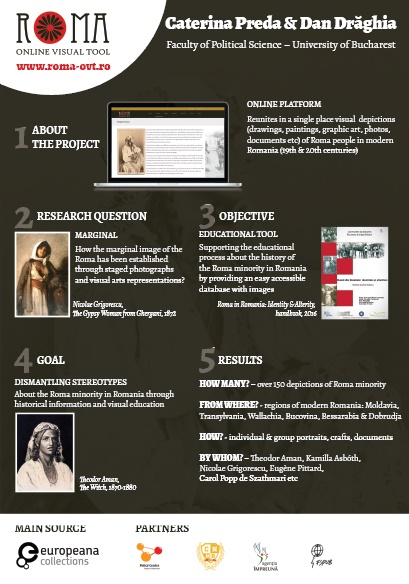 A visual tool for the display of the visual representations of the Roma of Romania in the 19th and 20th centuries in the Europeana collections: between stereotypes and truthfulness
A visual tool for the display of the visual representations of the Roma of Romania in the 19th and 20th centuries in the Europeana collections: between stereotypes and truthfulness
This project displays an online platform, which reunites the visual depictions of the Roma (also called Gypsies) of the current territory of Romania in the photo-archives, and visual arts sources (paintings, drawings, graphic art, film, etc.) of the Europeana collections. We argue that the current discrimination and marginalization of the Roma communities throughout Europe, and in Romania in particular, are based on a long historical process, which proceeds from the slavery of the Roma in Romania up to mid-19th century, and their subsequent assimilation as a marginal community.
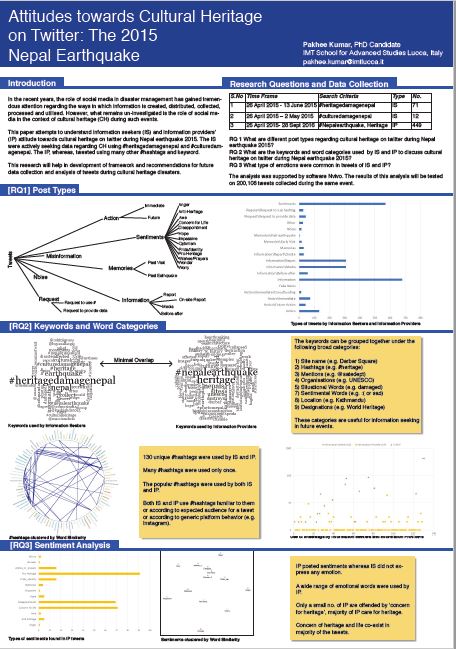 An Analysis of Attitudes towards Cultural Heritage on Twitter during Nepal Earthquake
An Analysis of Attitudes towards Cultural Heritage on Twitter during Nepal Earthquake
Addressing the gap in research in understanding the use of social media in the context of cultural heritage disasters, the poster attempts to understand information seekers and information providers’ attitude towards cultural heritage on Twitter during Nepal earthquake 2015. The research is done by the content analysis of manually collected 449 tweets using hashtag #Nepalearthquake with keyword heritage. These tweets are compared with 71 tweets collected manually using #heritagedamagenepal and 12 tweets collected manually using #culturedamagenepal. This analysis is the first step in understanding the data, which will be used later to test more data from Nepal earthquake.
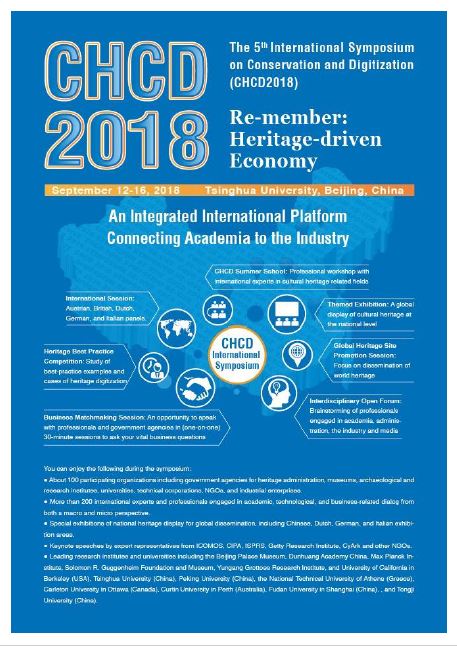 An Integrated International Platform to Connect the Academia and Industry --The 5th International Symposium on Cultural Heritage Conservation and Digitization (CHCD2018)
An Integrated International Platform to Connect the Academia and Industry --The 5th International Symposium on Cultural Heritage Conservation and Digitization (CHCD2018)
The International Symposium on Cultural Heritage Conservation and Digitization (CHDC) is an important international conference in the field of cultural heritage conservation and digitization, co-hosted by the International Committee for Documentation of Cultural Heritage (ICOMOS-CIPA), the Chinese National Committee for the International Council on Monuments and Sites (ICOMOS-China) and Tsinghua University. CHCD is started in 2010 and is held every two years. CHCD2018 is to be held on September 12-16, 2018 at Beijing, China. Under the theme “Re-member: Heritage-driven economy, CHCd2018 will discuss how modernity can decode and interpret cultural heritage and its historical information and value, as well as investigating the role cultural heritage can play as entrepreneurship development model in the contemporary era.
This poster is a short introduction to Ancient History Encyclopedia, the world’s most-read history encyclopedia. It is run by a non-profit company with the goal of getting more people interested in history. The preservation of cultural heritage starts in people’s minds, and getting them to understand how our history relates to the present is the best way to make people care about cultural heritage.
And Ankara Project intends to emphasize the significant change of the city from 1923’s to 2013. The Project holds a silent scream of Ankara audible against this change by comparing the old and present day Ankara and it intends to illustrate the architectural transformation of the city from the early years of Republic through present day. The etchings of preeminent buildings were placed on old photos were used to illustrate preserved buildings, and newly built skyscrapers that does not match with the original plan of the city. Within the scope of the Project two exhibitions were held in 2013 at the Turkish Post Office at the old Centrum of the city, Ulus and in 2016 at the Turkish Chamber of Architects Ankara Branch, Kızılay; new Centrum of the city.This poster presents And Ankara.. Project ‘s role through the exhibition of the cultural heritage of old and new Ankara, and the transformation of the city over the years.
Bagoly-lyuk (“Owl-hole”), officially Szúcs-Bányatelep, is a prime example of settler housing on a mining landscape. This settlement lies 3 km from the centre of Szúcs, north-west from Eger. By car it is only accessible on a secondary main road or on a forest track. The community and its population is characterised by physical, social and cultural segregation suffering from poor housing conditions, therefore, a number of community-building programmes were launched in 2015. The Autonomia Foundation and the Katona József Theatre have taken on organising theatre pedagogical and community-building programmes. Furthermore, there is a home improvement assistance programme founded with donations. What is still missing is the genius loci created by the community, a place for drama and solutions, a creative and self-creating space: a stage for both the individual and the community.
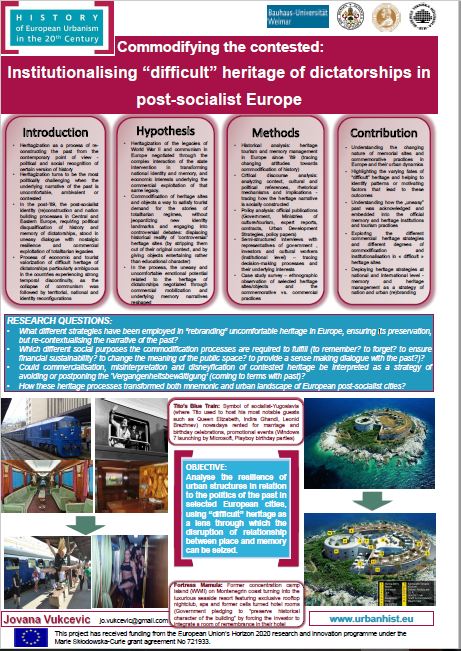 Commodifying the contested: Institutionalising “difficult” heritage of dictatorships in post-socialist Europe
Commodifying the contested: Institutionalising “difficult” heritage of dictatorships in post-socialist Europe
The poster will present part of the on-going research related to the role of uncomfortable heritage in nation branding, specially focusing on specificities of politics of memory, forgetting and revisionism in the post-socialist Europe. It will address the legacies of unwanted, ambivalent or unacknowledged past and different strategies employed by both states and private actors in re-branding their ‘contested’ heritage, ensuring its preservation, but re-contextualizing the narrative of the past through contemporary tourism practices. It questions the interplay between nostalgia, heritage and market, and the role of heritage in polishing the history of totalitarian and authoritarian regimes in the Balkans.
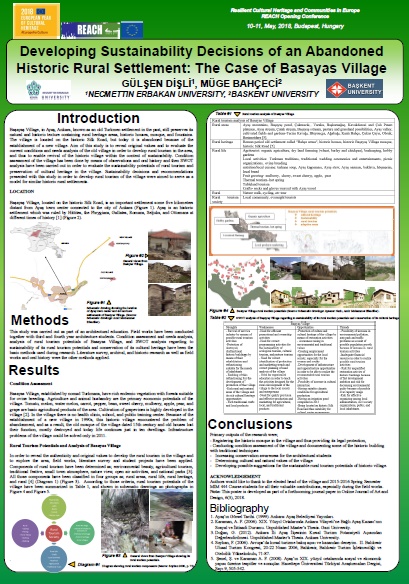 Developing Sustainability Decisions of an Abandoned Historic Rural Settlement: The Case of Basayas Village
Developing Sustainability Decisions of an Abandoned Historic Rural Settlement: The Case of Basayas Village
Başayaş Village, in Ayaş, Ankara, known as an old Turkmen settlement in the past, still preserves its natural and historic texture containing rural heritage areas, historic houses, mosque, and fountains. The village is located on the historic Silk Road, but today it is abandoned because of the establishment of a new village. Aim of this study is to reveal original values and to evaluate the current conditions and needs analysis of the old village in order to develop rural tourism in the area, and thus to enable revival of the historic village within the context of sustainability. Condition assessment of the village has been done by means of observations and oral history and then SWOT analysis have been carried out in order to evaluate the sustainability potentials of rural tourism and preservation of cultural heritage in the village.
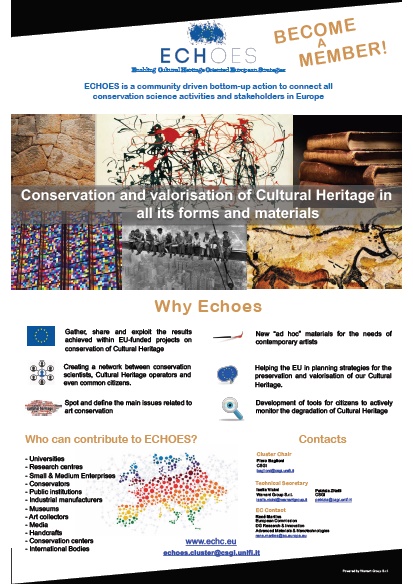 ECHOES “Enabling Cultural Heritage Oriented European Strategies"
ECHOES “Enabling Cultural Heritage Oriented European Strategies"
ECHOES is a new European initiative coordinated by CSGI and Warrant Group to connect all conservation science activities and stakeholders in Europe. The cluster is a bottom-up action open to all the people and institutions involved in the Cultural Heritage field to create a community and stimulate discussion between experts with different backgrounds. The network includes the major players from both academia and industrial sectors, policy makers, standard bodies and even common citizens.
eHERITAGE (‘Expanding the Research and Innovation Capacity in Cultural Heritage Virtual Reality Applications’) is a Coordination and Support project which addresses the “twinning” challenges described in the topic H2020-TWINN-2015 of the Work programme. The general objective of eHERITAGE project is to increase the capacity, quality and extent of the research staff of Transilvania University of Brasov, by establishing strong and sustainable research cooperation schemes with the partners, based on close scientific and social interaction. By creating applications for cultural heritage sites, eHERITAGE contributes to the spread of knowledge in the fields of history and arts, and having a department specialized in these techniques which is based in Romania if the first step in consolidating this research field in the eastern Europe.
 Forget Heritage – Validated methodology of creative revitalization of abandoned buildings in CE cities
Forget Heritage – Validated methodology of creative revitalization of abandoned buildings in CE cities
Forget Heritage will tackle the question of how to improve capacities of the public and private sector or sustainably using cultural heritage and resources in Italy, Slovenia, Germany, Poland, Croatia and Czech Republic. Most cities in these countries are characterised by the presence of unused historical buildings such as former factories, hospitals, schools, barracks that have marked the history of the local community.
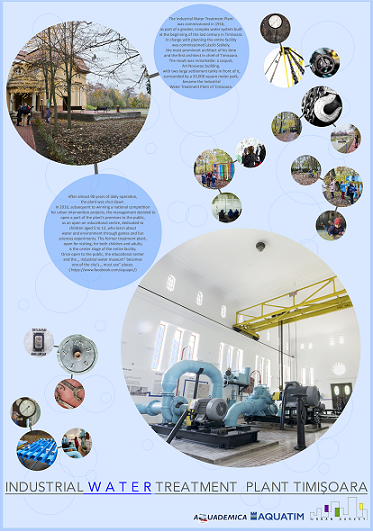 Former Industrial Water Plant Timisoara open to the public
Former Industrial Water Plant Timisoara open to the public
The project Former Industrial Water Plant Timisoara open to the public integrates into the regional cultural network an industrial facility, commissioned in 1916 and in preservation since 2006. Visiting the plant, with all its equipment kept intact and in place, is a genuine “immersion” in the past. Connecting people with their roots and history, the project reveals the value of the industrial heritage, as part of the cultural identity, and raises awareness on the community’s responsibility for its preservation. For Timisoara, this plant is the first piece of decommissioned local industrial heritage saved from degradation and from falling into oblivion. The project is under evaluation in the 2018 EU Prize for Cultural Heritage (reference number: HA-2018/RO/05).
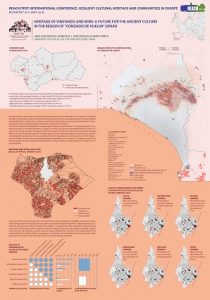 Heritage of vineyards and wine: a future for the ancient culture in the region of "Condado de Huelva" (Spain
Heritage of vineyards and wine: a future for the ancient culture in the region of "Condado de Huelva" (Spain
This research analyzes the possibility of considering the traditional vitiviniculture in "Condado de Huelva", southwest of Spain, as well as its associated elements. The goal is not only to set the most appropriate technical way of carrying it out, but also to argue the reasons that should support it, both for society and for the sector in question. The pioneering heritage interpretation of the region of has allowed the identification of a large and diverse system linked to the culture of vineyards and wine. The result of the research has been the concretion the values, tangible and intangible, cultural and natural, of this heritage and which would deserved social and institutional recognition.
 Hetor: Protection and Preservation of Campania Cultural Heritage
Hetor: Protection and Preservation of Campania Cultural Heritage
Hetor is a pilot project of ROUTE-TO-PA. It is devoted to stimulate local communities to co-create Open Data about Cultural Heritage, to improve the quality and quantity of the Open Data available about the protection and preservation of Cultural Heritage and enhancement of local cultural and environmental resources. The project has as a target the Campania Region in Italy. The initiatives involved three communities of the local territory: a community of citizens, a community of local associations' members and a community of students. In this study, we take into consideration the engagement of the local citizenship, which has been reached in particular with the Open Data Challenge experience. The citizens contributed to the creation of public value, in collaboration with the local Public Administration, by discussing topics in the context of the local Cultural Heritage. They generated information both from pre-existing and co-created open datasets, using the SPOD platform. These experiences represent a bottom-up approach that directly involves the citizenship in a series of crowdsourcing activities in the field of the Cultural Heritage, collecting data and disseminating the gained knowledge to the whole community.
Iconographical presentation of cultural heritage of European painter Ibrahim Kodra, was born in 1918 in Albania and he started to study in Italy from 1938. His artistical activities brought philosophical message with original identity through poetical and visual creations. After his passing, Ibrahim Kodra Swiss Foundation continues to diffuse his message about importance of peace through cultural and educational activities in Europe and other countries of the world. Some of images are present on the poster like a visual message. For example, educational activities for peace in Kosovo with young artists like cultural bridge of European heritage in the world.
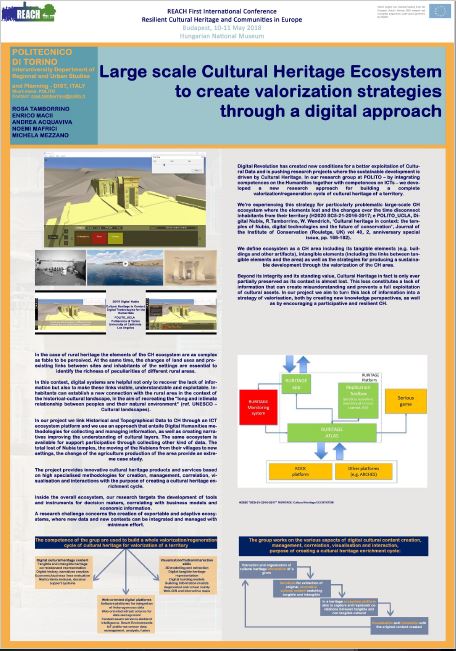 Large scale Cultural Heritage Ecosystem to create valorization strategies through a digital approach
Large scale Cultural Heritage Ecosystem to create valorization strategies through a digital approach
In our project we link Historical and Topographical Data to CH through an ICT ecosystem platform and we use an approach that entails Digital Humanities methodologies for collecting and managing information, as well as creating narratives improving the understanding of cultural layers. The same ecosystem is available for support participation through collecting other kind of data. The total lost of Nubia temples, the moving of the Nubians from their villages to new settings, the change of the agriculture production of the area provide an extreme case study.
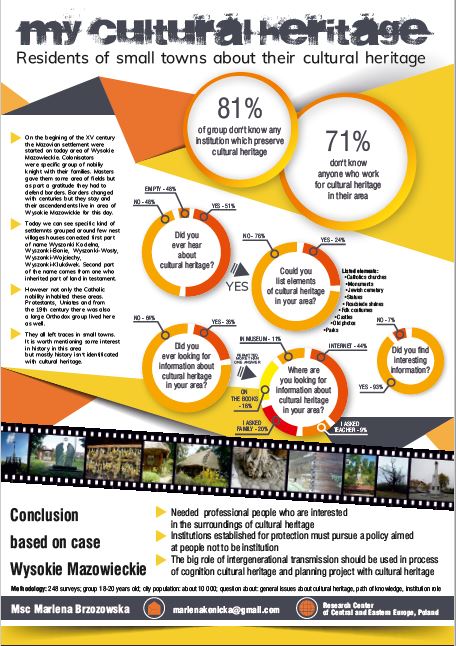 My Cultural Heritage.Young residents of small towns about their heritage.
My Cultural Heritage.Young residents of small towns about their heritage.
Small towns of Mazovian- Podlasie border, between Łomża and Białystok doubtless have multicultural history. In most of them was lived Catolics, Jews, Orthodox and Evangelics. They left traces on landcape and people rememberance. We should to ask people what they know about cultural heritage in places they are living – as a consequence, heritage left for them. Good way for asking is questionnaire adressed to adult, but still young people - high school graduates, study in four small towns schools (about 300 responders), who at least theoretically have unlimited acces to knowledge on the Internet. Where they meet cultural heritage? Where they get knowlage? The answer to these questions will allow to find the right channels to popularize knowledge about cultural heritage in small communities.
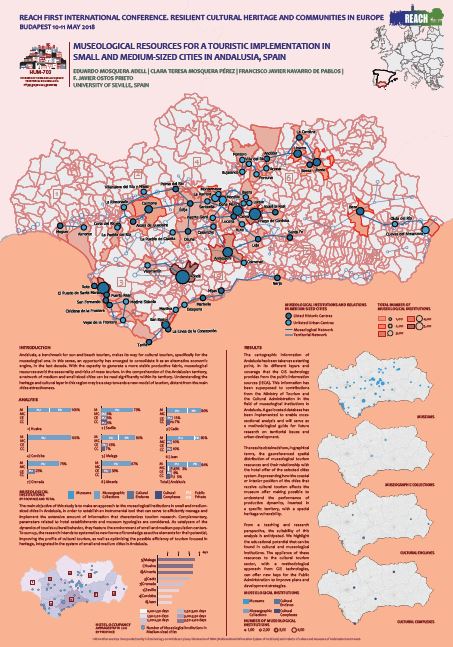 Museological resources in small and medium-sized cities in Andalusia
Museological resources in small and medium-sized cities in Andalusia
The main objective of this study is to make an approach to the museums in small and medium-sized cities in Andalusia, in order to establish an instrumental tool that can serve to efficiently manage and implement the extensive amount of information that characterizes tourism research. Complementary, parameters related to hotel establishments and museum typologies are considered. As catalyzers of the dynamics of tourist-cultural behavior, they feature the environment of small and medium population centers. To sum up, the research intends to systematize new forms of knowledge as active elements for their potential improving the profile of cultural tourism, as well as optimizing the possible efficiency of tourism focused in heritage, integrated in the system of small and medium cities in Andalusia.
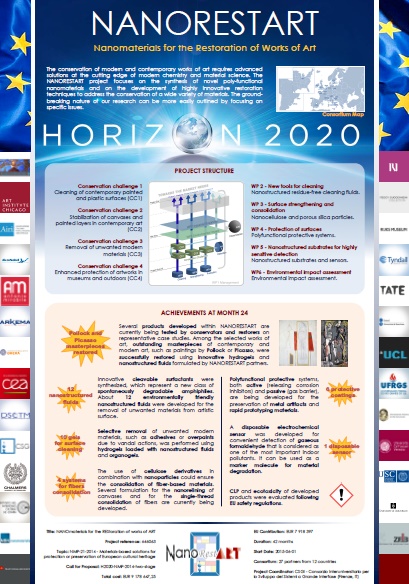 NANORESTART - NANOmaterials for the REStoration of works of ART
NANORESTART - NANOmaterials for the REStoration of works of ART
NANORESTART is an H2020 project coordinated by CSGI - University of Florence and it focuses on the preservation of modern and contemporary works of art. NANORESTART, with a budget of ca. 9 million euros, is an extraordinary example of the effective collaboration between natural and social sciences. The partnership (almost 30 partners) gathers the main research centres (CSGI, Chalmers University, National Research Council, UCL…), and museums (Solomon Guggenheim Collection, TATE Gallery…).
Saint Martin, the symbol of sharing, is one of the most popular saints in central Europe with thousands of monuments and intangible heritage (folk traditions, legends) keeping his memory alive. Partner cities of the NewPilgrimAge project are located along the European Cultural Route of Via Sancti Martini. They join forces to revive this cultural heritage and promote the common European values of solidarity and hospitality linked to St Martin. Cities and cultural organisations from five countries will mobilise their citizens, most of all young people and small enterprises, to propose and jointly develop new creative initiatives valorising the untapped heritage potentials.
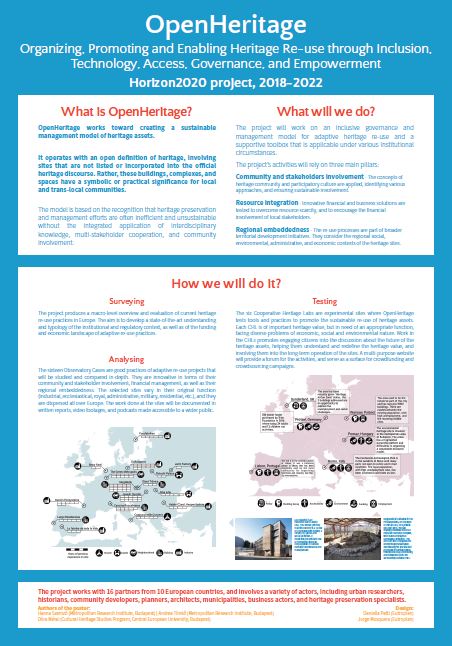 OpenHeritage: organizing, promoting and enabling heritage re-use through inclusion , technology, access, governance and empowerment.
OpenHeritage: organizing, promoting and enabling heritage re-use through inclusion , technology, access, governance and empowerment.
The poster aims to provide an insight into the main focus of OpenHeritage, a new H2020 project – about to begin in June, 2018 – which aims at developing and testing an inclusive governance model and a supporting toolbox for the adaptive reuse of cultural heritage assets. The project builds on the role of communities and the possibility of empowering them in the redevelopment process based on the concepts of heritage community and participatory culture. It operates with an open definition of heritage, not limited to listed assets but also involving those buildings, complexes, and spaces that have a symbolic or practical significance for local or trans-local heritage communities.
One of the preconditions for genuine sustainability is a heritage that is present anywhere and anytime in everyday life. We present PLUGGY, the Pluggable Social Platform for Heritage Awareness and Participation, an EU funded research project that aims to develop an innovative social platform and a suite of smartphone tools that will enable individuals, community groups, industry, museums and countries as a whole to bring out, document and share their heritage online and thereby celebrate Europe’s collective heritage.
Over the next two years, PLUGGY is expected to launch an inventive, Facebook-like social platform as well as a suite of Augmented Reality, Geolocation, 3D Sonic and Gaming smartphone apps that will enable citizens across Europe and the world to shape and pass on both individual and collective cultural experiences, thereby enhancing the value of cultural heritage and contributing towards its enrichment.
Through PLUGGY’s social platform and by using its innovative curation tools, designed to solely focus on a niche area in social media, citizens will be able to act as skilled “storytellers” by creating fascinating personalised stories and sharing them through social networking with friends, associates and professionals.
 ProteCHt2save – Risk assessment and sustainable protection of Cultural Heritage in changing environment
ProteCHt2save – Risk assessment and sustainable protection of Cultural Heritage in changing environment
The poster will focus on Interreg Central Europe Project ProteCHt2save’s main goal, the improvement of capacities of the public and private sectors to mitigate the impacts of climate change and natural hazards on cultural heritage sites, structures and artefacts, as the project focuses primarily on the development of feasible and tailored solutions for building resilience of cultural heritage to floods and events of heavy rain. First intermediary results of the project are ready to be presented by the poster and will focus on the state of the art of existing archives, maps, databases, and model outputs for risk evaluation concerning climate change related data.
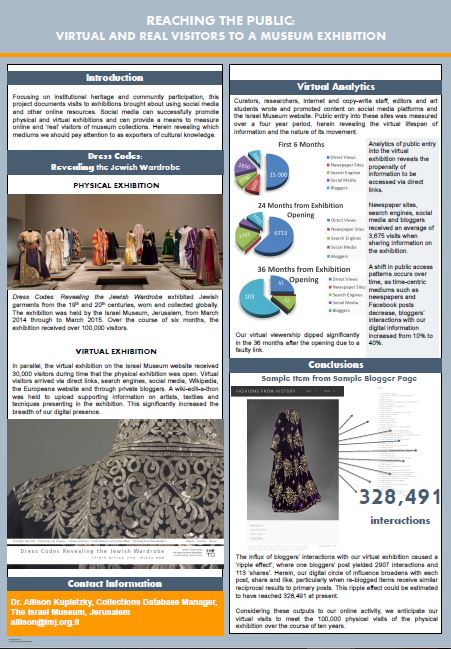 Reaching the Public: Virtual and Real Visitors to a Museum Exhibition
Reaching the Public: Virtual and Real Visitors to a Museum Exhibition
Focusing on institutional heritage and community participation, this project documents the visits to exhibitions brought about using social media other online resources. The real life exhibition “Dress Codes: Revealing the Jewish Wardrobe” was exhibited in the Israel Museum in Jerusalem in 2014 – 2015 and received over 100,000 visitors. In parallel, the virtual exhibition was placed online and received 30,000 visitors over the same length of time. The virtual visitors arrived via direct links, google, Facebook, Europeana, Wikipedia, Tumblr, Pinterest, YouTube, and private bloggers. A wiki-edit-a-thon was hosted during this period of time. Curators, researchers, internet and copywrite staff, editors and art students, were all involved both in promoting and writing in these social media platforms. The results of these activities and how they effected the influx of virtual visitors will be discussed in this poster.
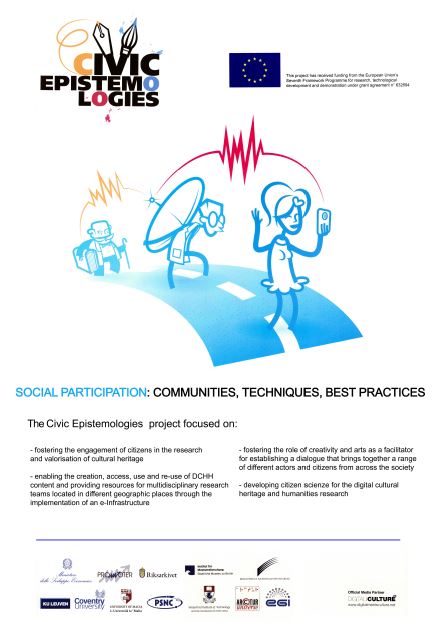 Roadmap of CIVIC EPISTEMOLOGIES
Roadmap of CIVIC EPISTEMOLOGIES
CIVIC EPISTEMOLOGIES is a previous EU project about the participation of citizens in research on digital Cultural Heritage and humanities and its main outcome is this Roadmap.
Roma culture in Austria
The population of Roma exists in Austria since the fin de siècle in culture, language and history. This poster will exhibit the most important Austrian Roma artworks, such as paintings, literature, music and theatre, as well as literary works in Roma translations. The locations of preservations are mostly found in Vienna, Burgerland, Graz and are bound to Austrian institutions.
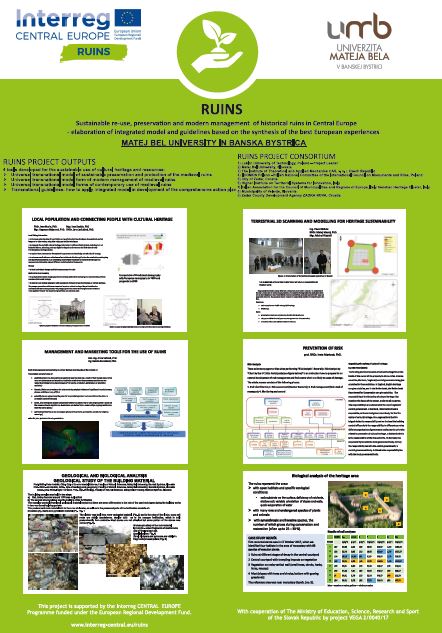 RUINS: Sustainable re-use, preservation and modern management of historical ruins in Central Europe
RUINS: Sustainable re-use, preservation and modern management of historical ruins in Central Europe
Topic of project are medieval ruins. In Europe there are at least several thousand historical ruins. Owners and managers of these sites struggle with the same problems: protection of ruins is problematic due to ongoing process of destruction, and modern use of ruins is limited. Ruined historical buildings are often either neglected or increasingly transformed. They lose their key features – authenticity and integrity. Problem applies to entire Europe.
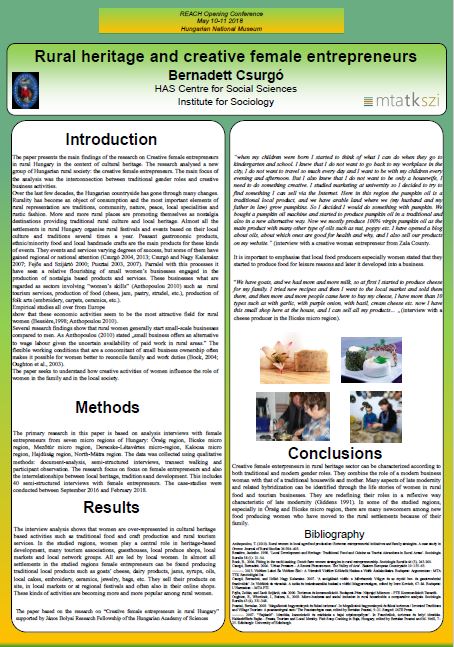 Rural heritage and creative female entrepreneurs
Rural heritage and creative female entrepreneurs
The poster presents the main findings of the research on Creative female entrepreneurs in rural Hungary in the context of cultural heritage. The analysis shows that women are over-represented in cultural heritage based activities and initiatives. The case studies from seven rural regions from Hungary prove that women play a central role in heritage-based development, many tourism associations, guesthouses, local produce shops, local markets and local network groups. All are led by local women and many of the creative enterprises run by rural women are based on local heritage.
 The fate of East Prussian Heimatmuseen and the memory of the Masurians in the years 1945-2017
The fate of East Prussian Heimatmuseen and the memory of the Masurians in the years 1945-2017
Until the end of the World War II, a large part of today north-eastern Poland belonged to the province of Germany called East Prussia. During the first three decades of the 20th century, several local and regional museums were created there. They were called Heimatmuseen. Their collections contained exhibits related to the history and heritage of the East Prussia. Right after World War II, in the second half of the 1940s, new Polish residents have appeared here, as a result of mostly forced migration of Polish and Ukrainian people and displacement of former German and Masurian inhabitants. At the same time new political, social and cultural reality have started to create the new memory of the new inhabitants. This political and social process, along with previous war devastation, caused destruction of most of Heimatmuseen. Only few of them have survived thanks to the efforts of Mazurian autochthons, but their exhibitions have been heavily changed. Exhibits from other museums have been taken to the new Masirian Museum in Olsztyn or destroyed. The surviving exhibits were used to create a new exhibition showing the Polish history of Masuria. These actions were ordered by the Polish government and the communist party
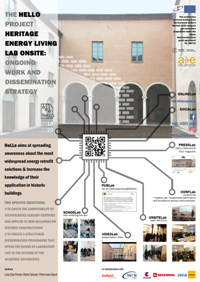 THE HeLLo PROJECT, Heritage energy Living Lab onsite: Ongoing work and Dissemination strategy
THE HeLLo PROJECT, Heritage energy Living Lab onsite: Ongoing work and Dissemination strategy
The HeLLo project has two specific objectives: to check the compatibility of thermal insulation technologies on historic constructions and, to create a structured dissemination programme that opens the doors of laboratory life to the outside of the academic boundaries. Herein, part of the work that has been developed so far is shown, through its various dissemination labs. DOI: 10.5281/zenodo.3929533.
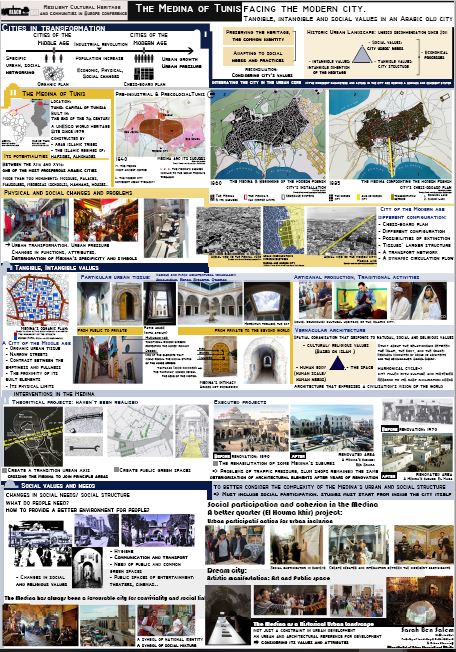 The Medina of Tunis facing the modern city. Tangible, intangible and social values in an Arabic old city
The Medina of Tunis facing the modern city. Tangible, intangible and social values in an Arabic old city
The objective of the poster is to present the rehabilitation project of the Medina of Tunis, which was designated by UNESCO as a World Heritage Site in 1979. We will analyse the interaction between the tangible and intangible values in the city, from the one side, and the social needs and practices, from the other side. We will evaluate if the social implication and participation are taken into consideration in the main urban projects and interventions in the Medina. As a conclusion, we will suggest a reflexion of how to consider the different tangibles and intangibles parameters of the city and involving the social groups to preserve the city’s identity and respond to its users’ needs.
TRACES is a three-year project funded in 2016 by the European Commission as part of the Horizon 2020 Research and Innovation Programme. TRACES investigates the challenges and opportunities raised when transmitting complex pasts and the role of difficult heritage in contemporary Europe. Transmitted sensitively, these heritages can contribute to a process of reflexive Europeanisation that is shaped by on-going critical reflection, and dialogue across different positions.
In order to achieve these objectives, TRACES has initiated a series of “Creative Co-Productions” in which artists, researchers, heritage agencies, and stakeholders research together on selected cases of contentious heritage to develop new participatory public interfaces. They are supported and complemented through several investigations pertaining to different research fields and disciplines with the aim to identify new directions for cultural institutions and museums.
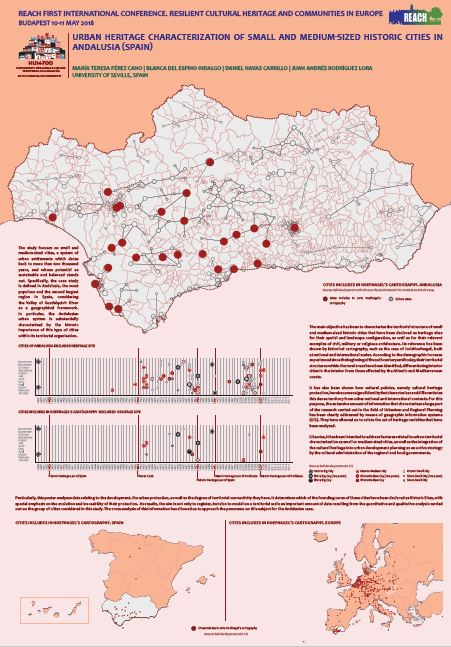 Urban heritage characterization of small and medium-sized historic cities in Andalusia (Spain)
Urban heritage characterization of small and medium-sized historic cities in Andalusia (Spain)
The main objective of this study is to make an approach to the museums in small and medium-sized cities in Andalusia, in order to establish an instrumental tool that can serve to efficiently manage and implement the extensive amount of information that characterizes tourism research. Complementary, parameters related to hotel establishments and museum typologies are considered. As catalyzers of the dynamics of tourist-cultural behavior, they feature the environment of small and medium population centers. To sum up, the research intends to systematize new forms of knowledge as active elements for their potential improving the profile of cultural tourism, as well as optimizing the possible efficiency of tourism focused in heritage, integrated in the system of small and medium cities in Andalusia.
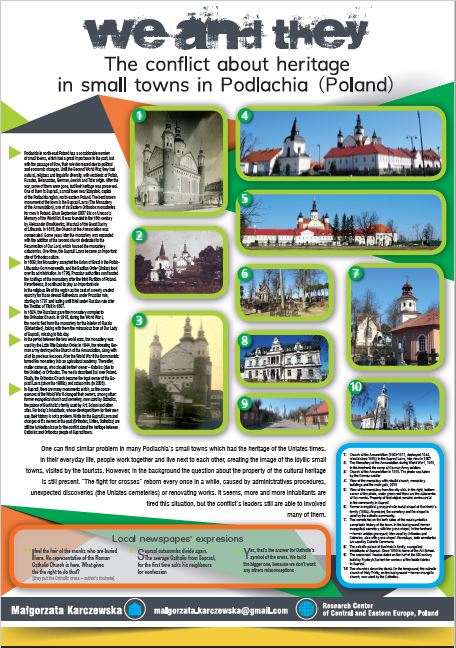 We and they. The conflict about heritage in small towns in Podlachia (Poland )
We and they. The conflict about heritage in small towns in Podlachia (Poland )
The poster will present several questions about the cultural heritage of small towns in north-eastern Poland, such as Supraśl or Tykocin. Until the Second World War, these towns had cultural, religious and linguistic diversity, with residents of Polish, Russian, Belarussian, German, Jewish and Tatar origin. After the war, some of them were gone, but their heritage was preserved. The depositaries of it are modern inhabitants of these cities, first of all Roman Catholic and Orthodox. What is their attitude to the abandoned heritage of other nations and religions? Are there any problems with cultural legacy of the groups that continue to live in these cities? Are there inflammatory points that have a genesis in the past, which lack of solutions translates into modern conflicts?

